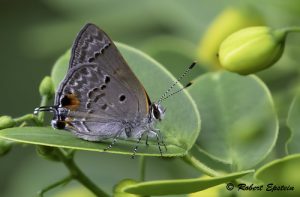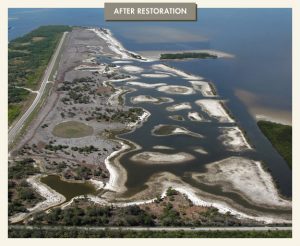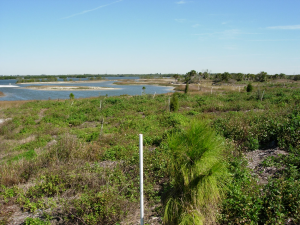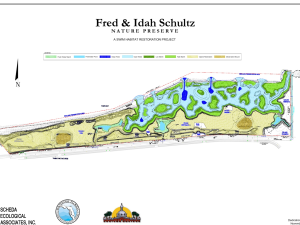[printfriendly] [su_pullquote align=”right”][/su_pullquote]
Naturalists looking for diverse ecosystems couldn’t find a better package than the 120-acre Fred and Ida Schulz Preserve in Ruskin. From uplands covered in pines and palms to mangrove forests rimming a series of wetlands that deepen into protected estuaries with artificial reefs, it’s all here in one short hike or kayak trip.
Even more amazing is the fact that the Schultz Preserve was sculpted by bulldozers and planted by people.

Fifty years ago, it was part of what old-timers called “The Kitchen” because they knew they could always catch a meal in the lush seagrass beds or thriving oyster reefs. That was before developers decided to dredge and fill 300 acres to create a port facility in the 1960s.
Luckily, it sat empty until 1995 when Hillsborough County and the Southwest Florida Water Management District (SWFWMD) purchased the north side of the peninsula and Port Tampa Bay bought the south side with deep-water access.
SWFWMD’s SWIM (Surface Water Improvement and Management) program took on the challenge of transforming the nearly flat peninsula covered in Brazilian pepper, cogon grass and Australian pines into a mosaic of habitat that attracts wildlife – and people who come to see it.
 “We built in as much complexity as we could,” says Brandt Henningsen, who was the senior environmental scientist with SWIM until he retired. “It mimics Mother Nature with mounds and dips and curves that encourage diverse wildlife.”
“We built in as much complexity as we could,” says Brandt Henningsen, who was the senior environmental scientist with SWIM until he retired. “It mimics Mother Nature with mounds and dips and curves that encourage diverse wildlife.”
Schultz Preserve also includes nearly 50 acres of estuarine habitat along with five artificial reefs where small fish can hide from predators. That estuarine habitat is among the most valuable in the bay because 95% of Florida’s fishes, crustaceans and shellfish spend a portion of their lives in low-salinity habitats.
The 120-acre site also encompasses 10 acres of freshwater wetlands, strategically located to capture stormwater from neighboring properties as well as the preserve itself. The wetlands “polish” fully treated stormwater from the port’s side of the peninsula before it’s discharged into the bay.

An innovative partnership with Hillsborough County’s reclaimed water department will increase the flow of freshwater into Schultz’s wetlands as it drains from an abandoned fish farm being restored specifically to shelter larval fish, particularly tarpon and snook.
That makes for an incredible mosaic of habitats. Tampa Audubon Society documented 145 species of birds, 47 species of butterflies, 226 species of plants (including 141 natives) and “vast, widespread oyster beds” with five other species of mollusks, crabs and worms during a bioblitz held in January 2018.
Hiking the preserve as part of the Florida Birding and Nature Festival, we found 27 species of butterflies and 25 species of birds, including a bald eagle soaring overhead, in just two hours.
 It also hosts the northernmost breeding colonies of Julia butterflies, which makes it a regular stop for John Lampkin, a nature festival leader who also takes his out-of-town visitors to Schultz. “Usually you have to travel far east and south to see this butterfly,” he says. “Schultz is good for them because it has water on three sides of the peninsula so it never freezes.”
It also hosts the northernmost breeding colonies of Julia butterflies, which makes it a regular stop for John Lampkin, a nature festival leader who also takes his out-of-town visitors to Schultz. “Usually you have to travel far east and south to see this butterfly,” he says. “Schultz is good for them because it has water on three sides of the peninsula so it never freezes.”
The birding festival trip focused on butterflies but Tampa Audubon also does monthly site surveys to document the preserve’s value. They typically begin before dawn so that the hundreds of crows, gulls, herons, egrets and ibis can be counted as they fly out of their roosts on nearby islands.
If you go:
To hike DO NOT follow your GPS instructions if it tells you to turn right on Kracker Avenue. Instead, turn right on Adamsville Road which leads back to the Kracker Avenue address. Trails are not well marked and can be rough. Good walking shoes are required.
With a kayak or canoe, turn right onto Kracker Avenue. It dead-ends at an “unofficial” boat ramp. Paddle straight down the channel and you’ll see Shultz’s open water lagoon to the south, and the other islands of “The Kitchen” to your right.
To join Tampa Audubon’s site surveys, contact mcmic40″-AT-“msn.com for dates and times.
Learn more about how a flat, featureless peninsula became one of the region’s most ecologically diverse preserves by checking out our 2004 story on the Schultz Preserve.
[su_divider]